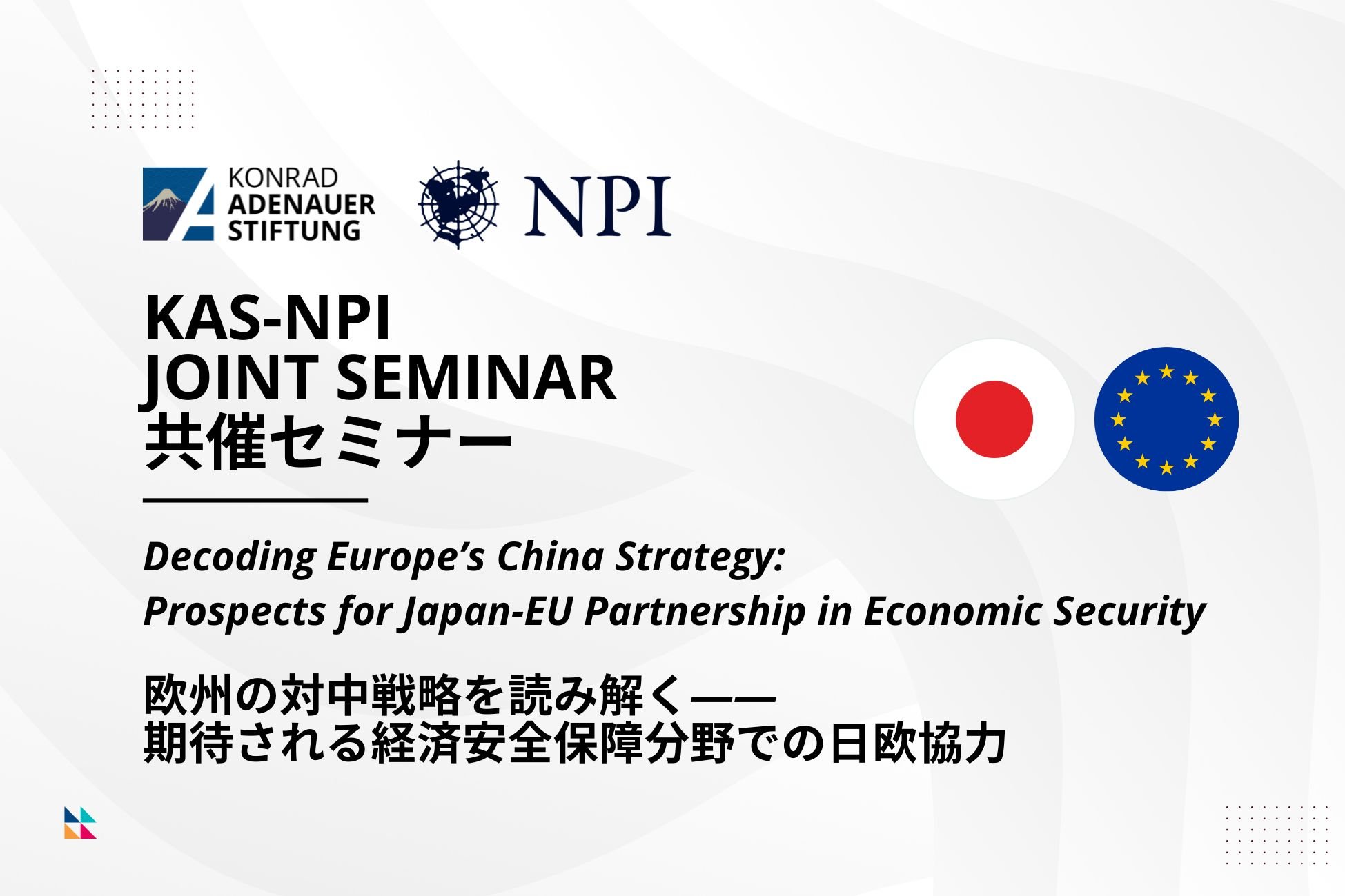2015/03/23
Akira Yasuda, "Preferential Trade Agreements -- Their Evolution and Limitations"
[PDF version] (The article appeared originally in Japanese in IIPS Quarterly, dated January 27, 2015).
In the post-World War Two era, a multilateral system has been employed to support trade liberalization and regulation, and to maintain order within the global trading system. This multilateral system was built first around GATT, which was established in 1947, and then around the World Trade Organization (WTO), which evolved from GATT. Underlying this system was the belief that the pre-war formation of exclusive economic blocs by the major world powers had been one of the causes of the war, and that preventing a recurrence of this situation required global economic prosperity by means of a multilateral system of trade that was free of discrimination and based on the most‑favored‑nation principle.
On the other hand, the point has been made that, since the 1990s, the growing trend for concluding preferential trade agreements (PTAs) which mainly consist of free-trade agreements (FTAs) has served to undercut this basic ideal. The current state of affairs, in which the popularization of PTAs has virtually neutralized the GATT/WTO system's basic principle of most‑favored nations, has even been cited as necessitating revision of the post-war Bretton Woods system.
The evolution of preferential trade agreements
A look at the process that led to acceptance of PTAs as exceptions to most-favored-nation status within GATT reveals that under the draft charter of the International Trade Organization (ITO)--the body initially devised after the war--approval for preferential relationships was mainly restricted to cases involving either relationships between former colonial powers and their old colonies, or the preservation of existing customs unions. Subsequently, countries that were dissatisfied with being treated in a way that preserved the disparity between the advanced nations and themselves demanded approval for the building of new preferential relationships aimed at economic development or economic recovery, and this led to the acceptance of the PTA concept. This gave impetus to a succession of recommendations for the acceptance of preferential tariff relationships as exceptions to most-favored-nation treatment, and approval was granted both to customs unions and to free-trade areas that are equivalent to the FTAs that are so prevalent today.
After this, the ITO concept faltered and, in the course of the establishment of the GATT agreement (which took the notion of the "minimum regulation necessary" from the draft charter for the ITO), GATT did not inherit the requirement that approval of new preferential relationships be contingent on the goal of economic development or economic recovery. On this point, Haruo Saburi (writing in 2001) criticized the draft charter as follows: "While it did contain provisions to lessen the requirements for exceptions to the principle of most-favored-nation treatment--in light of sentiment that preferential relationships for economic development or recovery should be allowed, it was incomplete in that it did not include provisions that positively permitted exceptions for purposes of economic development or recovery." An examination of the course of events involved in the construction of the post-war system affirms that the current prevalence of large-scale PTAs is not what was originally intended.
The first development under the GATT system was the progress in Europe towards the establishment of the European Economic Community (EEC). While a final decision was deferred on whether the EEC would adhere to GATT rules, an integration plan was advanced, and continuation of the agreement effectively represented a common interpretation that a PTA would continue to exist "legitimately" as long as the GATT system does not point out otherwise. Adopting a stance that contrasted with Europe's actions, the USA initially expressed reservations about any new organization based on preferential treatment, out of its respect for the most-favored-nation principle. As European integration progressed, however, the USA gradually came to recognize that it would need to establish a trading bloc to compete with Europe. Thus, the USA changed tack and concluded the North American Free Trade Agreement (NAFTA) with Canada and Mexico.
Even under the WTO, which was inaugurated in 1995, it cannot be claimed that the check mechanisms designed to ensure that preferential agreements are not being established without reasonable grounds (and thus do not unduly proliferate) are working. The international community has effectively connived to block the working of these GATT/WTO mechanisms and has thus encouraged the subsequent conclusion of further preferential agreements.
The accelerating trend towards preferential agreements is frequently attributed to the failure of trade liberalization negotiations to get off the ground at the WTO Ministerial Conference of 1999, and to the fact that the current Doha Round of negotiations has stalled. However, the increasing trend in preferential relationships was already evident during European integration back in the GATT era and when the USA switched over to placing greater emphasis on preferential relationships. The trend was also undoubtedly solidified by the rejection of drastic reform to the rules on preferential relationships at the time that the WTO was established. Thus, the stalling of WTO negotiations on trade liberalization could instead be seen as the result of this trend rather than its cause.
The current proliferation of preferential relationships
The conclusion of bilateral preferential agreements continued apace during the 2000s, with over 250 cases recorded. There is a sense that the conclusion of preferential agreements at the bilateral level has come full circle. Attention is now being drawn to their disadvantages, such as the detrimental effects that these arrangements have on domestic industry and the fact that--even after they have been concluded--their usefulness is not readily apparent. As to the economic effectiveness of preferential agreements, although countries hope to secure more beneficial arrangements by negotiating with a larger trading partner, negotiation with a larger partner is naturally more difficult, and political considerations also have to be taken into account. Also worthy of note is the phenomenon of supply chain segmentation, especially in Asia, that occurs as production and distribution systems expand outwards from the nations of industrialized Asia (including Japan) and spread to multiple other nations. This yields both advantages and disadvantages, depending on whether or not preferential relationships have been established.
That being the case, it is inevitable that nations will, as a matter of course, seek expanded preferential relationships--that is, frameworks involving many countries instead of just two--and that, as a result, these relationships will be larger in scale. Without a doubt, 2013 was a banner year in the growth of this phenomenon, as a succession of negotiations commenced towards the establishment of large-scale FTAs--a Japan-China-Korea free-trade agreement, a Japan-EU Economic Partnership Agreement, the East Asian Regional Comprehensive Economic Partnership (RCEP), and an FTA between the USA and the EU (the TTIP). Although it is unclear at this point whether all these negotiations will bear fruit, there is a growing appreciation that, in all probability, the time is rapidly approaching when large-scale preferential relationships will be prolific.
Three limitations of preferential trade arrangements
There are also various limitations to preferential arrangements, as well as causes for concern associated with them. First, there are fears of increased economic disparities between those countries that are actively proceeding to conclude preferential arrangements, and those countries or regions that are excluded from preferential trade relationships. In particular, although African and Middle Eastern countries have built preferential relationships within their own regions, they enjoy few preferential arrangements with nations outside their areas. Second, there are worries that preferential agreements on a larger scale will throw inconsistencies between trade rules into sharp relief, causing the creation of unnecessary trade barriers. Third, although most preferential agreements prescribe procedures for dispute settlement, their application is limited. On the other hand, it also cannot be denied that--depending on their nature--procedures for resolving disputes based on preferential agreements could undermine the authority and stability of existing judicial or dispute settlement systems, and could in the long term be detrimental to the preservation of the international trade and investment order. These concerns are illustrated by the controversy that has arisen in the course of the TTIP negotiations between the USA and the EU over the rights and wrongs of the provisions for the investor-state dispute settlement.
Although there are varying degrees of awareness of these fears, in this era of proliferating preferential relationships, the recognition of a need for some kind of function for coordinating between different preferential agreements is gradually spreading (as shown, for example, by JETRO's 2014 Global Trade and Investment Report). It is, after all, the WTO--indispensable to the global trading system--that should fulfill this role. Despite fearing a decline in the influence of the WTO, in 2012 Akira Kotera wrote in regard to this point that the WTO (which consisted of 160 countries after recent newly accessions such as that of Russia in 2012) "has grown into a global international institution, in reality as well as in name," and added that "there is no doubt that the WTO has the potential to play a key role in maintaining and developing the global trade order." The WTO is expected to fulfill its potential by playing this coordination role. The search for the optimal nature of this function (which will entail issues such as incorporating more flexibility in the WTO decision-making process) will likely continue.
Currently, as the major powers proceed to build interregional preferential relationships on a global scale, it is difficult to imagine their forming exclusive blocs and coming into conflict--at least in the short term. However, it is impossible to dispel the fear that the chaotic proliferation of large-scale preferential agreements (even if they temporarily increase the economic welfare of participating nations) could prove disadvantageous to countries and regions that are excluded from preferential trade relationships, and it could increase economic disparity between states, thereby destabilizing the international order. The issues associated with preferential arrangements, as well as their limitations, are topics that require further consideration.
Main references
Haruo Saburi, "GATT/the WTO and Regional Integration" in 100 Years of International Law and Japan--No. 7, International Trade (Sanseido, 2001).
Mitsuo Matsushita, "The Role of the WTO in the Golden Era of FTAs and EPAs" in Journal of the Japanese Institute of Business Law, Vol. 42, No. 1 (2014).
Akira Kotera, "The WTO as a Venue for the Establishment of Trade Rules" in Japan's Economic Recovery and the Roadmap for Growth (Bushindo, 2012).
Junji Nakagawa, The WTO--Beyond Trade Liberalization (Iwanami Shoten, 2013).





